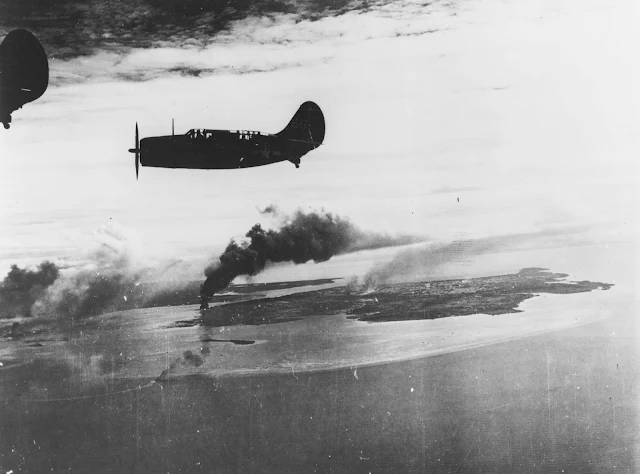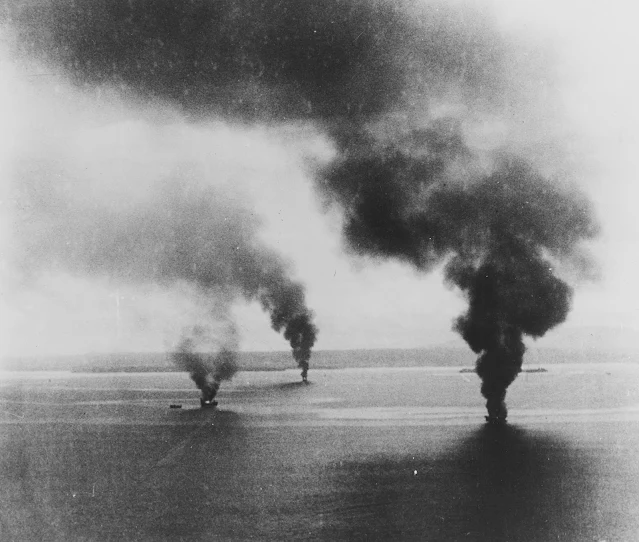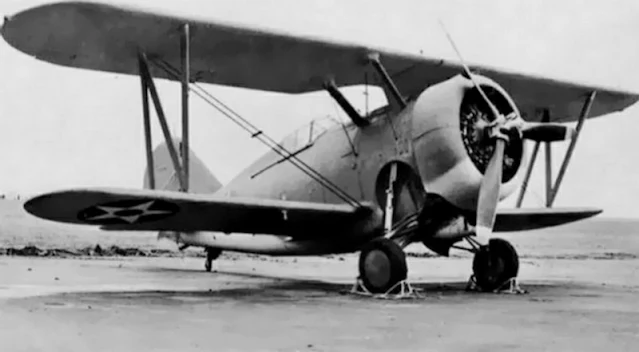 |
Curtiss P-40 Warhawk 42-104590 “Lulu Belle” White 44. Curtiss P-40 Warhawk "Lulu Belle" was a P-40N operated in India against the Japanese and flown by 2nd Lt. Philip Adair of the 10th Air Force, 80th Fighter Group. The reason for the choice of this motif comes from the 89th Fighter Squadron in which Lt. Adair flew; they knew that the Japanese were incredibly superstitious about images of death and so they painted skulls, which varied from aircraft to aircraft, on the cowlings to scare the enemy pilots.
|
80th Fighter Group
Constituted as 80th Pursuit Group (Interceptor) on 13 Jan 1942. Activated on
Feb 1942. Re-designated 80th Fighter Group in May 1942. Used P-47's to train
for combat and to serve as part of the defense force for the northeastern US.
Sailed for India, via Brazil, Cape of Good Hope, and Ceylon, in May 1943.
Assigned to Tenth AF. Began operations in Sep 1943 with P-38 and P-40 aircraft;
later used P-47's. Supported Allied ground forces during the battle for
northern Burma and the push southward to Rangoon, bombing and strafing troop
concentrations, supply dumps, lines of communication, artillery positions, and
other objectives. Defended the Indian terminus of the Hump route by striking
Japanese airfields and by patrolling Allied airfields to safeguard them from
attack. Received a DUC for intercepting a formation of enemy planes and
preventing its attack on a large oil refinery in Assam, India, on 27 Mar 1944.
Returned to the US in Oct 1945. Inactivated on 3 Nov 1945.
Squadrons
88th: 1942-1945
89th: 1942-1945
90th: 1942-1945
459th: 1943-1944
Stations
Selfridge Field, Mich, 9 Feb 1942
Farmingdale, NY, 5 Jul 1942
Mitchel Field, NY, 9 Mar-30 Apr 1943
Karachi, India, 28 Jun 1943
Nagaghuli, India, Oct 1943
Tingkawk Sakan, Burma, 29 Aug 1944
Myitkyina, Burma, 20 Jan 1945
Dudhkundi, India, 24 Maya Oct 1945
Camp Kilmer, NJ, 1-3 Nov 1945
Commanders
Unkn, Feb-May 1942
Col John C Crosthwaite, c. 20 May 1942
Maj Albert L Evans Jr, 1 Jul 1942
Col Ivan W McElroy, 14 Jul 1943
Col Albert L Evans Jr, 13 Apr 1944
Col Sydney D Grubbs Jr, 1 Feb 1945
Col Hiette S Williams Jr, c. 29 Apr 1945-unkn
Victories
88th Fighter Squadron: 8 victories
89th Fighter Squadron: 23 victories
90th Fighter Squadron: 12 victories
459th Fighter Squadron: 66.5 victories
 |
| Curtiss P-40F Warhawk fighters are being hoisted onto the USS Chenango at Pier 7, NOB Norfolk, Virginia, October 15, 1942. |
 |
| A Curtiss P-40F Warhawk (41-14305) fighter is being hoisted onto the USS Chenango at Pier 7, NOB Norfolk, Virginia, October 15, 1942. |
 |
| The top two U.S. aces of World War II. Maj Richard Bong and Maj Thomas McGuire. McGuire was killed in combat on January 7, 1945 and Bong died in the crash of a P-80 jet he was test flying on August 6, 1945. |
 |
| Curtiss P-36 Hawks. |
 |
| Curtiss P-36A Hawk US Army Air Corps. |
 |
| Curtiss P-36C Hawk, US Army Air Corps. Photographed at the National Air Races, Cleveland, Ohio, USA, September 1, 1939. These P-36Cs belonged to the 27th Pursuit Squadron of the 1st Pursuit Group, 2nd Wing, General Headquarters Air Force based at Selfridge Field, Michigan, USA. The leading aircraft is s/n 38-85 with the number 69 on the tail (the 6 is hardly visible). The aircraft were on display at the National Air Races to show not only the US Army's preparedness, but also the various camouflage schemes tested at Fort Bragg, North Carolina, USA, during the Carolina War Games of 1939. Twelve P-36C's were painted in this unusual camouflage, in the picture accompanied by six "normal" painted aircraft. The schemes were of three classes: Class I: One to three dark colors on top (ground camouflage) with white or gray underneath (sky camouflage). Class II: The ground camouflage on top with the outline broken up by sand or white. No camouflage underneath. Class III: Confusion scheme, non-concealment with the same camouflage colors being used on top and underneath. Within each Class there were several variations on patterns and colors. The colors used were water based temporary camouflage paint, as follows: Dark Blue, Dark Green, Dark Olive, Neutral Gray, Sand (believed to have been an orange shade of sand), Sea Green, and White. |
 |
| Curtiss P-36C Hawk, US Army Air Corps. Photographed at the National Air Races, Cleveland, Ohio, September 1, 1939. The aircraft in the center of the photo is s/n 38-85 with the number 69 on the tail. |
 |
| Boeing Y1P-26 Peashooter (XP-936). |
 |
| Boeing P-26A Peashooter. |
 |
| Boeing P-26A (33-125), 94th Pursuit Squadron, Oakland, California, May 1936. Pilot Lt. John S. Chennault. |
 |
| Boeing P-26A US Army Air Corps. |
 |
| Boeing XP-936 (32-412) US Army Air Corps. |
 |
| Boeing P-26 (32-414) US Army Air Corps. Photographed at Barksdale Field, Shreveport, Louisiana, January 23, 1934. |
 |
| Boeing P-26C US Army Air Corps. |
 |
| Boeing P-26B US Army Air Corps, Seattle, Washington, 1933. |
 |
| Three of the Boeing F4B-3 aircraft that the US Marine Corps used in 1933. These craft are shown in flight on 30 October 1933. |
 |
| Boeing F4B-3 (A-8892 c/n 1596) US Navy. The F4B-3 was the USN production equivalent of the P-12E with the semi-monocoque metal fuselage, and 21 were ordered on April 23, 1931, together with 92 F4B-4s, the latter differing only in having enlarged vertical tail surfaces, and life raft stowage in an enlarged streamlined headrest on the last 45 examples. Both were designated Model 235 by their manufacturer. |
 |
| Boeing F4B-4 US Navy. |
 |
| Boeing F4B-2 (A-8635 c/n 1414), Fighting Squadron Six, US Navy. |
 |
| Boeing P-12E (32-56), AC Reserve, Oakland Airport, 1939, when the Army Air Corps had half of Hangar One. |
 |
| Ridgefield PG-2, serial number 42-77062, a powered glider. The idea was to use the glider normally and after landing attach the engines and fly it home. |
 |
| Crashed Republic P-43A fighter. This particular aircraft is serial 40-2921, pictured in November 1941. It was part of the USAAC's 55th Pursuit Group, originally activated at Hamilton Field, Novato, California. This photograph is taken at Portland Army Air Base, OR, which also hosted the 55th. The P-43s of the 55th Pursuit Group primarily conducted training operations until August 1943 when the group was moved to England for operations over Western Europe. |
 |
| Seversky 1XP (r/n R 18Y) after crash landing at Floyd Bennett Field, New York, September 1, 1937. At the right, men have extinguished the resulting fire. |
 |
| North American O-47A, 37-299. |
 |
| North American O-47A, 37-330, Griffith Park California National Guard Base. |
 |
| Curtiss YO-40 Raven prototype recon aircraft. The YO-40 was the main prototype of the O-40 Raven recon aircraft. It was developed starting in 1931 and the prototype first flew in February of 1932. The aircraft was powered by a 653 hp Wright R-1820E Cyclone radial engine. The aircraft was subsequently ordered into production in 1932/33. |
 |
| Curtiss O-40B Raven observation aircraft. |
 |
| Douglas O-38B, assigned to the Maryland National Guard's 104th Observation Squadron, parked on the flight line on 9 May 1934. The Maryland National Guard was equipped with O-38Bs from February 1932 to March 1937. |
 |
| Douglas O-38E. |
 |
| Douglas O-38E (33-4), California National Guard, Alameda, 1939. |
 |
| Douglas O-38B. |
 |
| Douglas O-38E. |
 |
| Northrop N-9M. |
 |
| View of Nagasaki showing the destruction wrought by the atomic bomb dropped on 9 August 1945. |
 |
| De Havilland Mosquitos, USAAF. |
 |
| Allied XLRA-1 amphibious glider. |
 |
| Allied LRA-1 (BuNo 11648) on its beaching gear. |
 |
| Allied LRA-1 (BuNo 11648) glider on its beaching gear. |
 |
| Allied LRA-1 (BuNo 11648) on its beaching gear. |
 |
| Allied Aviation XLRA-1 transport flying boat glider prototype. |
 |
| Marine Corps LNS-1 gliders for student pilots at Page Field, Parris Island, South Carolina. May 1942. |
 |
| A U.S. Marine Corps NAF N3N-3 “Yellow Peril” towing three LNS-1 gliders at Parris Island, South Carolina. May 1942. |
 |
| Marine Corps student glider pilots preparing for a training flight in their Schweizer LNS-1. Parris Island, South Carolina, May 1941. |
 |
| Pratt-Read LNE-1 glider. The Navy ordered 100 gliders with the designation LNE. The PR-G1 was a monoplane glider and had a fabric-covered steel tube fuselage and wooden wings and tail. The Pratt-Read TG-32 was a 1940s American military training glider, designed and built by the Gould Aeronautical Division of the piano manufacturer Pratt, Read & Company of Deep River, Connecticut, for the United States Navy. The Pratt-Read glider was a monoplane glider having a fabric-covered steel tube fuselage and wooden wings and tail. The unique "polywog (tadpole)" shape was the suggestion of aerodynamicist Charles Townsend Ludington, former owner of the Ludington Line. |
 |
| Pratt-Read LNE-1 (31558). When the decision was made not to use gliders in the Pacific campaign, 73 of the Navy aircraft were transferred to the United States Army Air Forces in exchange for two Pratt-Read manufactured CG-4A Army gliders which the Navy had been experimenting with. The LNE-1 gliders were then given the AAF designation of TG-32. The Air Force did not use the gliders and they were stored until the end of the war and were sold on the civilian market. |
 |
| Sergeant McConachie of the 94th Bomb Group with his L-5 Sentinel (42-99306). |
 |
| Stinson L-5B Sentinel (44-16902) at East Wretham, home of the 359th Fighter Group. |
 |
| Stinson L-5 Sentinel (42-98998), 7th Photographic Reconnaissance Group, Mount Farm. |
 |
| Aeronca O-58B Grasshopper US Army Air Forces. |
 |
| Aeronca O-58 Grasshopper US Army Air Corps. |
 |
| Aeronca L-3 Grasshopper. |
 |
| Aeronca L-3 Grasshopper. |
 |
| Grumman J4F Widgeon, U.S. Coast Guard. |
 |
| Grumman J4F-2 Widgeon being crated for shipment circa 1944. |
 |
| Grumman J4F-2 Widgeon being crated for shipment circa 1944. |
 |
| Grumman J4F-2 Widgeon being crated for shipment circa 1944. |
 |
| Airspeed Horsa gliders. |
 |
| Airspeed Horsa glider. |
 |
| Airspeed Horsa glider. |
 |
| C-47s towing Airspeed Horsa gliders as they fly over the Normandy beaches. |
 |
| Airspeed Horsa glider after landing during training as C-47 tow planes fly overhead. |
 |
| Hughes H-4 Hercules (NX37602), Long Beach Harbor, California, 2 November 1947. The Spruce Goose taxiing in Long Beach Harbor. The giant flying boat famously made only one short flight. |
 |
| Great Lakes BG-1 (9807), VB-4, Bombing Squadron Four, visiting Oakland, 1938. |
 |
| Beech GB-2 Traveler BuNo 01626. |
 |
| Beech GB-2 Traveler, NAS Pensacola, Warrington, Florida, ca. 1942-45. |
 |
| Beech GB-2 of the National Naval Aviation Museum, Pensacola, Florida, which arrived in 1984, and is painted in the markings of an aircraft assigned to Naval Air Station (NAS) Pensacola, Florida. |
 |
| A Goodyear dirigible of the M Class, which had a helium capacity of 725,000 cubic feet. |
 |
| Berliner-Joyce OJ-2 BuNo 9852. |
 |
| Berliner-Joyce XOJ-3 BuNo 9196 Anacostia. |
 |
| Berliner-Joyce XOJ-3. |
 |
| AT-12 Guardsman twin-seat trainer. The AT-12 was derived from the twin-seat Seversky 2PA. All AT-12s were originally 2PAs that didn't get exported abroad—the leftovers. These remaining aircraft, of which there were 50, were handed over to the U.S. Army Air Corps (late-1930s). The AT-12s were rearmed with a combination of .30 cal and .50 cal machine guns. |
 |
| September 12, 1944: Japanese-occupied harbor of Cebu is under attack by U.S. Navy carrier-based fighter planes, at Cebu island, Philippines. |
 |
| Air strikes in the Visayas, 12 September 1944. SB2C bombers from task force 38 fly past Cebu, after attacking installations and shipping there, 12 September 1944. US National Archives 80-G-247516. |
 |
| Air strikes in the Visayas, 12 September 1944. Planes from task force 38 aircraft raiding Japanese shipping off Cebu, Cebu, 12 September 1944. US National Archives 80-G-247511. |
 |
| Air strikes in the Visayas, 12 September 1944. Planes from task force 38 strike installations and shipping at Cebu City, Cebu, 12 September 1944. US National Archives 80-G-247510. |
 |
| Douglas Dolphin. The Douglas Dolphin is an American amphibious flying boat. While only 58 were built, they served a wide variety of roles including private air yacht, airliner, military transport, and search and rescue. The U.S. Army Air Corps ordered several under the designations C-21, C-26, and C-29. |
 |
| James Doolittle and fellow Raiders at a reunion in Miami Beach, Florida, United States, 19 April 1947. |
 |
| General James Dootlittle. |
 |
| Gen. James Harold “Jimmy” Doolittle, USAAF. |
 |
| Grumman F3F (1-MF-2) of Marine Fighting 1, prewar. |
 |
| Aviation Cadet Thanas inspects a Grumman F3F engine. Naval Air Station Corpus Christi, 1942. |
 |
| Grumman F3F, early war camouflage and markings. |
 |
| Grumman F3F-3, Anacostia. |
 |
| Grumman F3F-3, Anacostia. |
 |
| Grumman XF3F-1, Anacostia. |
 |
| Grumman F3F-1 (BuNo 0264). |
 |
| Grumman F3F-2 (BuNo 1018). |
 |
| Grumman F4F-4 Wildcats from Fighting Squadron 71 (VF-71) and Royal Air Force Supermarine Spitfire Mk.Vc of No. 603 Squadron RAF on the deck of the aircraft carrier Wasp (CV-7) on 19 April 1942. Having landed her torpedo planes and dive bombers at Hatson in Orkney, Wasp had loaded 47 Spitfires of No. 603 Squadron at Glasgow on 13 April, then departed on the 14th for "Operation Calendar". Wasp and her consorts passed through the Straits of Gibraltar under cover of the pre-dawn darkness on 19 April. At 0400 on 20 April, Wasp spotted 11 Wildcats on her deck and launched them to form a combat air patrol. Meanwhile, the Spitfires were warming up their engines and later launched for Malta. When the launch was complete, Wasp retired toward Gibraltar. |
 |
| Grumman F4F-3S Wildcatfish. The Wildcatfish was inspired by the Japanese success in adding floats to their A6M2 Zero fighter, and was intended to fill the same requirement – to provide fighter protection to islands in the Pacific where airfields were not available. |
 |
| Two large aluminum floats were designed for the Wildcat by the EDO Aircraft Corporation of Long Island, NY. The aircraft was not amphibious, wheeled beaching gear was attached to the floats in order to bring the aircraft ashore. F4F-3 Bureau Number 4038 was converted for the trails. Note that the propeller tips are painted in the pre-war three-color warning stripes. The wing guns appear to have been removed, but the bomb racks are in place. |
 |
| Two small auxiliary rudders were attached to the horizontal tailplanes to provide additional yaw control, which was required by the large surface area of the floats. The standard wheel well openings were skinned over. |
 |
| The configuration was first flown on 28 February 1943 at Norfolk. Only a single aircraft was converted. |
 |
| Testing revealed the aircraft was unstable in yaw, so additional tail surface area was added under the fuselage. The Japanese A6M2-N “Rufe” floatplane also had a similar modification. |
 |
| The floats reduced the top speed and maneuverability of the Wildcatfish, which was a major liability as the Japanese Zero was already faster and more agile than a standard Wildcat. The U.S. Navy’s Seabee Construction Battalions had also proven themselves remarkably efficient at constructing airfields. The modification was not put into production, and the Wildcatfish slipped into obscurity. |































































































No comments:
Post a Comment